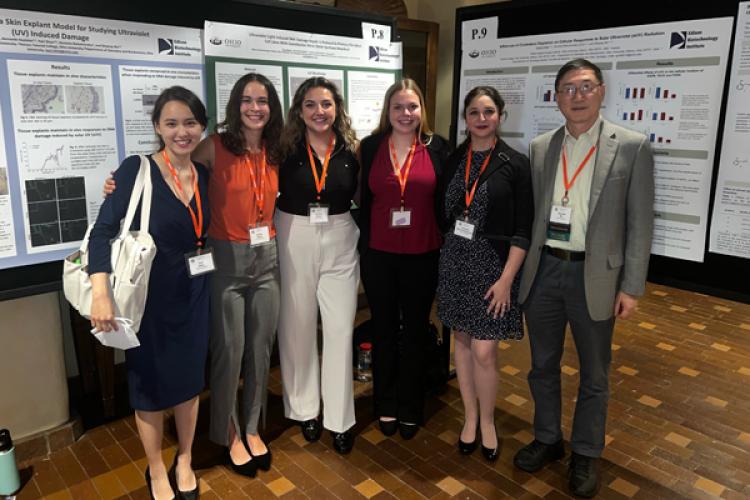
Shiyong Wu lab showcases student, alumna researchers at American Society for Photobiology meeting

Shiyong Wu took one graduate student, three undergraduate students and an OHIO alumna to the American Society for Photobiology meeting this fall to showcase the types of research that Ohio University students are doing on ultraviolet exposure and basal cell skin cancer.
Wu, professor of chemistry and biochemistry and a member of the Molecular Cellular Biology program in the College of Arts and Sciences, received a five-year $1.7 million National Institute of Environmental Health Sciences grant in 2019 to advance research on a potential prevention and treatment for non-melanoma skin cancers in the Edison Biotechnology Institute lab.
"Everyone in the team, especially Veronica Bahamondes, have contributed significantly to our NIH-funded project in studying ultraviolet light induced carcinogenesis," Wu said. "Veronica was an invited speaker to give an oral presentation in the session of 'Natural Products in Prevention of Photodamage and Photocarcinogenesis.' The students' posters attracted attention from many attendees."
Wu also noted that after the meeting he received an email from Dr. Georg Wondrak, the former president of ASP, noting that he 'was impressed by the UV/ ER stress mechanistic focus of your current research; also it was encouraging interacting with your bright students including Evelyn Potter, who guided me through her poster.'
ASP was formed 50 years ago to promote research on chemical and physical changes involving non-ionizing radiation.
Three Honors Tutorial College (HTC) undergraduate students presented their work, thanks to travel awards from the Ohio University Travel Fund (Undergraduate Student Travel Fund) and the Honors Tutorial College dean’s funding.
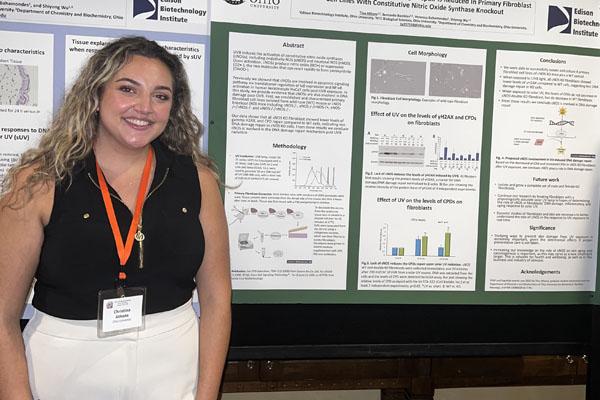
Tina Athans, an HTC student, presented a poster on "Ultraviolet Light Induced DNA Damage Repair is Reduced In Primary Fibroblast Cell Lines With Constitutive Nitric Oxide Synthase Knockout."
"At the ASP conference, I presented a poster of my research on UV-irradiated fibroblasts. I am studying the cellular response to UV radiation in fibroblasts with and without the enzymes that produce nitric oxide. I received useful feedback and comments on my project that I will be incorporating into my senior thesis project," said Athens, who received travel awards from the Ohio University Travel Fund (Undergraduate Student Travel Fund) and the Honors Tutorial College Dean’s Funding. "I really enjoyed this conference and exploring the city of Albuquerque. I was impressed not only by the science being done, but the passion the scientists had when presenting their research."
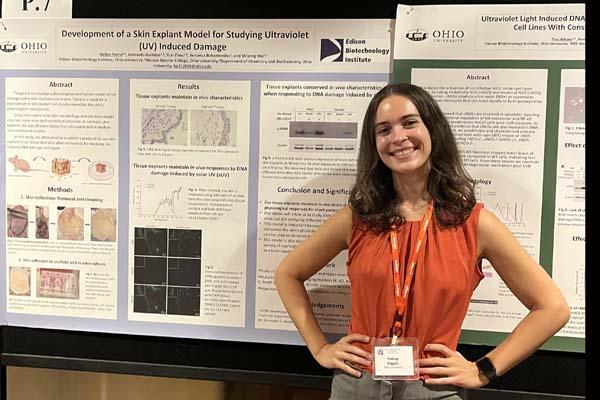
Hailey Payne presented a poster on "Creating and Standardizing a Skin Explant Model for Studying Solar Ultraviolet (sUV) Induced Damage and Repair."
"My presentation for the American Society for Photobiology conference showcased my preliminary data for my Honors Tutorial College thesis project titled 'Development of a Skin Explant Model for Studying Ultraviolet (UV) Induced Damage.' Skin explant models are cuts of intact skin tissue that are kept alive in cell culture medium; they are a way to study skin-related conditions such as cancer, as well as cosmetics and pharmaceuticals in a format that is very similar to a living animal such as a mouse or human without actually having to test potentially dangerous products on a living mouse or human," Payne said.
"Being able to present a poster at the American Society for Photobiology Conference was a really great way to hear constructive feedback from experts in the field on the preliminary data of my thesis project. I was able to discuss ways in which I can improve my data and make changes to my project from individuals who are also studying explant models. I also attended several presentations given by these researchers and gained inspiration and knowledge from them. One of my favorite presentations from the conference was about using photodynamic therapy to treat basal cell carcinoma. Overall this experience was very influential for developing my thesis project and learning other topics in the field of photobiology," she added.
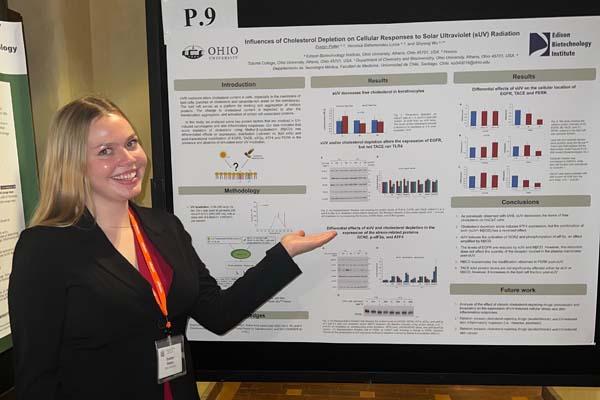
Evelyn Potter presented a poster on "Influences of Cholesterol Depletion on Cellular Responses to Solar Ultraviolet (sUV) Radiation."
"I presented a poster analyzing cholesterol depletion's influences on cellular responses to solar ultraviolet radiation (sUV). My research looked at integrative stress responses and inflammatory markers after cholesterol depletion and sUV treatment," Potter said. "It was an amazing opportunity to meet other scientists in the field and be part of the collaborative work that occurs. I also enjoyed exploring the city of Albuquerque."

Yuxi Zhou, a graduate student from the Chemistry and Biochemistry Department in the College of Arts and Sciences, presented a poster on "Identification of factors in regulation of IKKα post-UVB irradiation."
"The study of my work focused on the basic mechanism of skin responses to the UV exposure. NF-κB, one of the important pathways related to inflammation, will be activated post-UV irradiation. In my research, I investigated the mechanism for the regulation between NF-κB and cNOS both in vitro and in vivo," said Zhou, who received travel awards from the ASP Urbach Student Travel Award and OHIO's Chemistry and Biochemistry Department. "I was excited to talk to many people in the field, who gave me lots of inspirations and suggestions for my future research work."
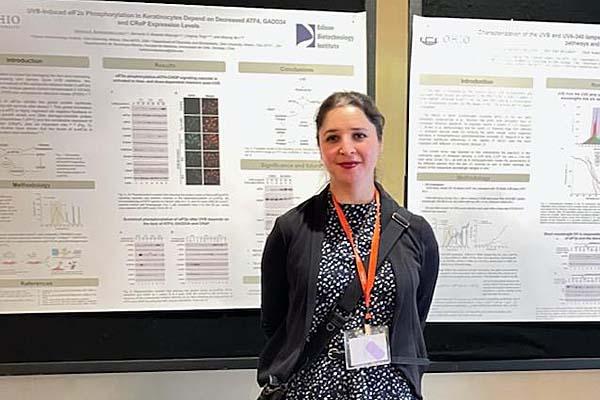
Veronica Bahamondes, a postdoc at the Edison Biotechnology Institute, presented two posters and an oral presentation:
- Poster: UVB-Induced eIF2α Phosphorylation in Keratinocytes Depend on Decreased ATF4, GADD34 and CReP Expression Levels
- Poster: Characterization of the UVB and UVA-340 lamps and determination of their effects on ER stress pathways and DNA damage
- Oral presentation: "The Role of Carnosol in Reducing Skin Cancer Development and Progression"
"My work is focused on analyzing the cellular responses that skin cells have after their exposure to solar UV radiation. This includes studying how pathways involved in overcoming stress are activated or repressed after UV exposure," said Bahamondes, who is also an OHIO alumna, having earned a Ph.D. in Chemistry from the College of Arts and Sciences in 2021.
"My talk was part of a new session on the ASP focused on the study of the protective attributes of natural compounds against UV radiation. All these works have as their final goal the understanding of the mechanisms that are involved in skin cancer formation and possible ways to avoid and treat it," she noted.
One of Bahamondes' posters is a collaborative work that includes Faiz Rahman, associate professor of electrical and computer science in the Russ College of Engineering and Technology, Alexander O. Govorov, distinguished professor of physics and astronomy in the College of Arts and Sciences, and Óscar Ávalos-Ovando, a visiting research scholar in physics and astronomy and an OHIO alumnus, having earned a Ph.D. in Physics from the College of Arts and Sciences in 2018. Both Rahman and Govorov are members of the Nanoscale Quantum Phenomena Institute (NQPI).
"The most important part was to be able to interact with researchers in this area of study and to share opinions, receive feedback, and create connections and possible collaborations. In addition, this was my first experience giving a talk in this type of activity, which was very enriching for my training," said Bahamondes, who received an ASP Urbach Student Travel Award.
